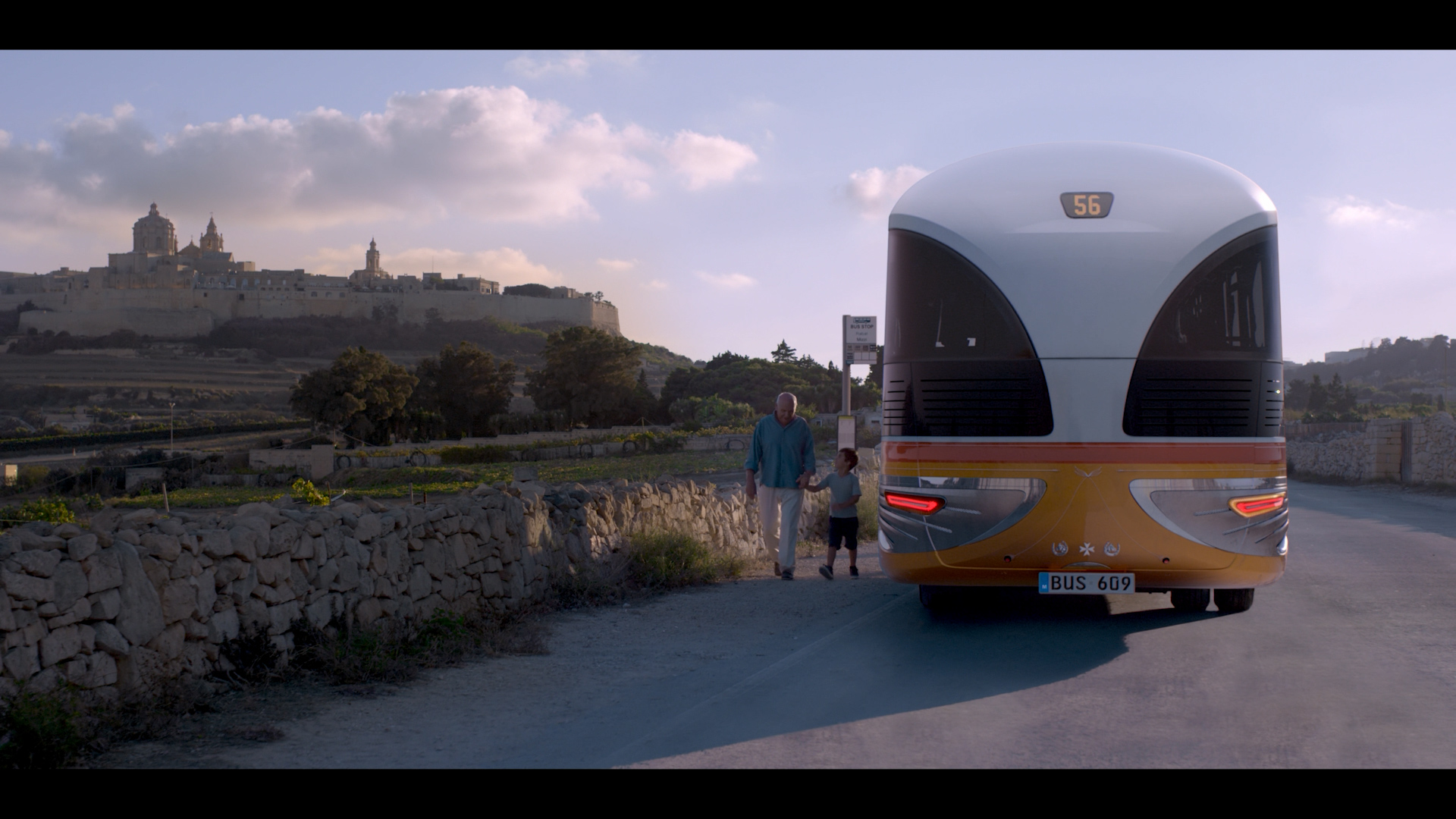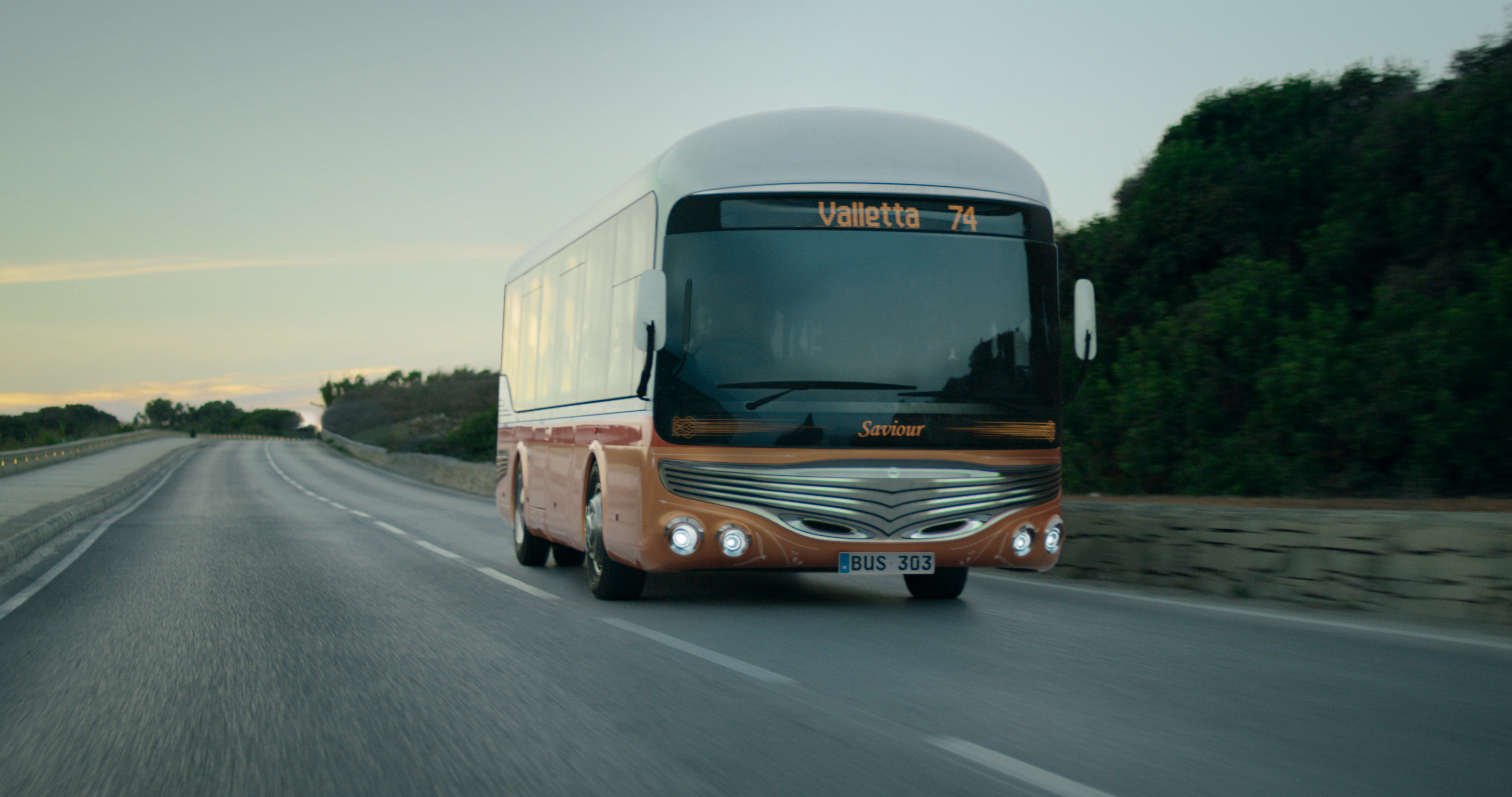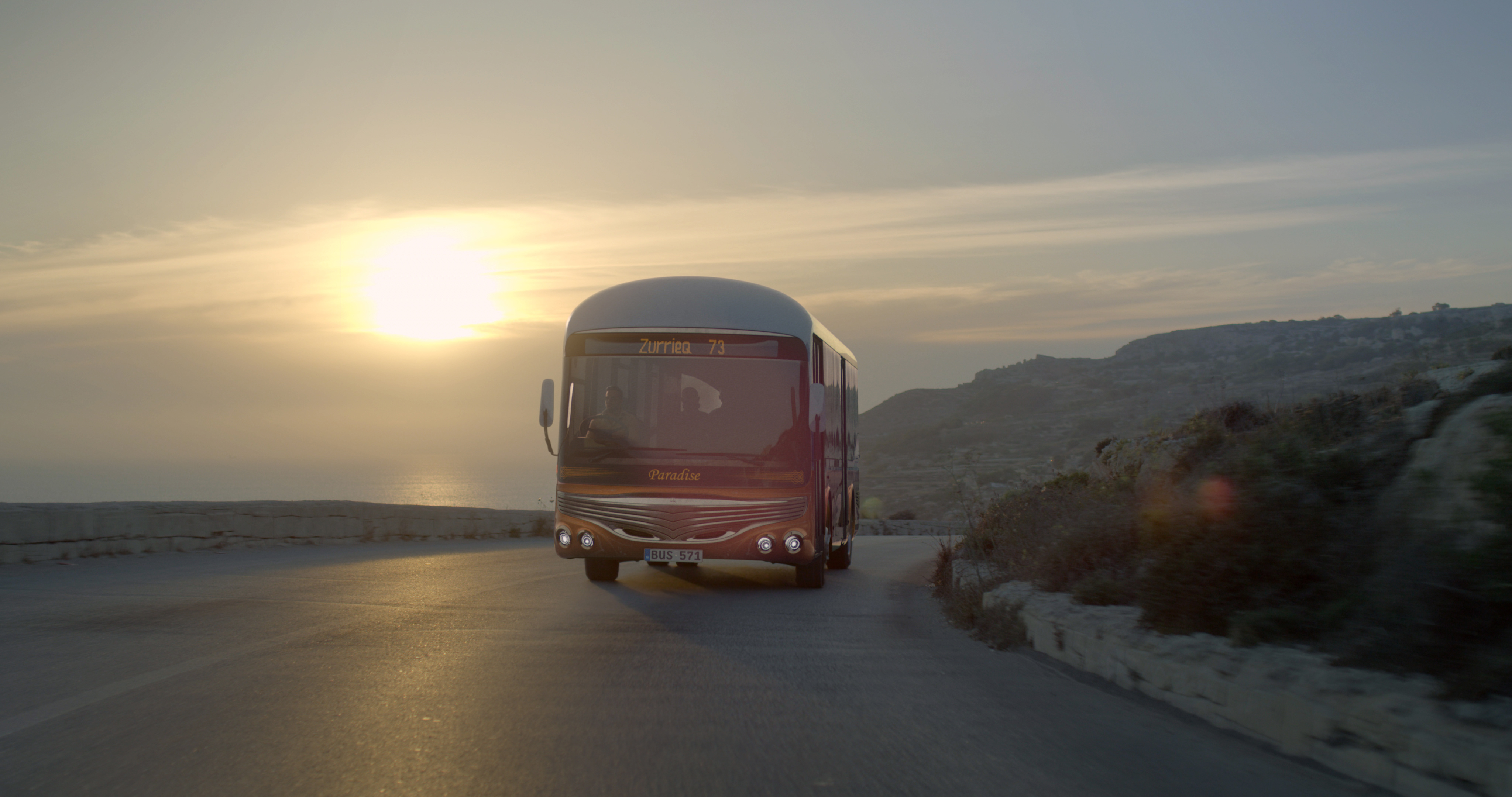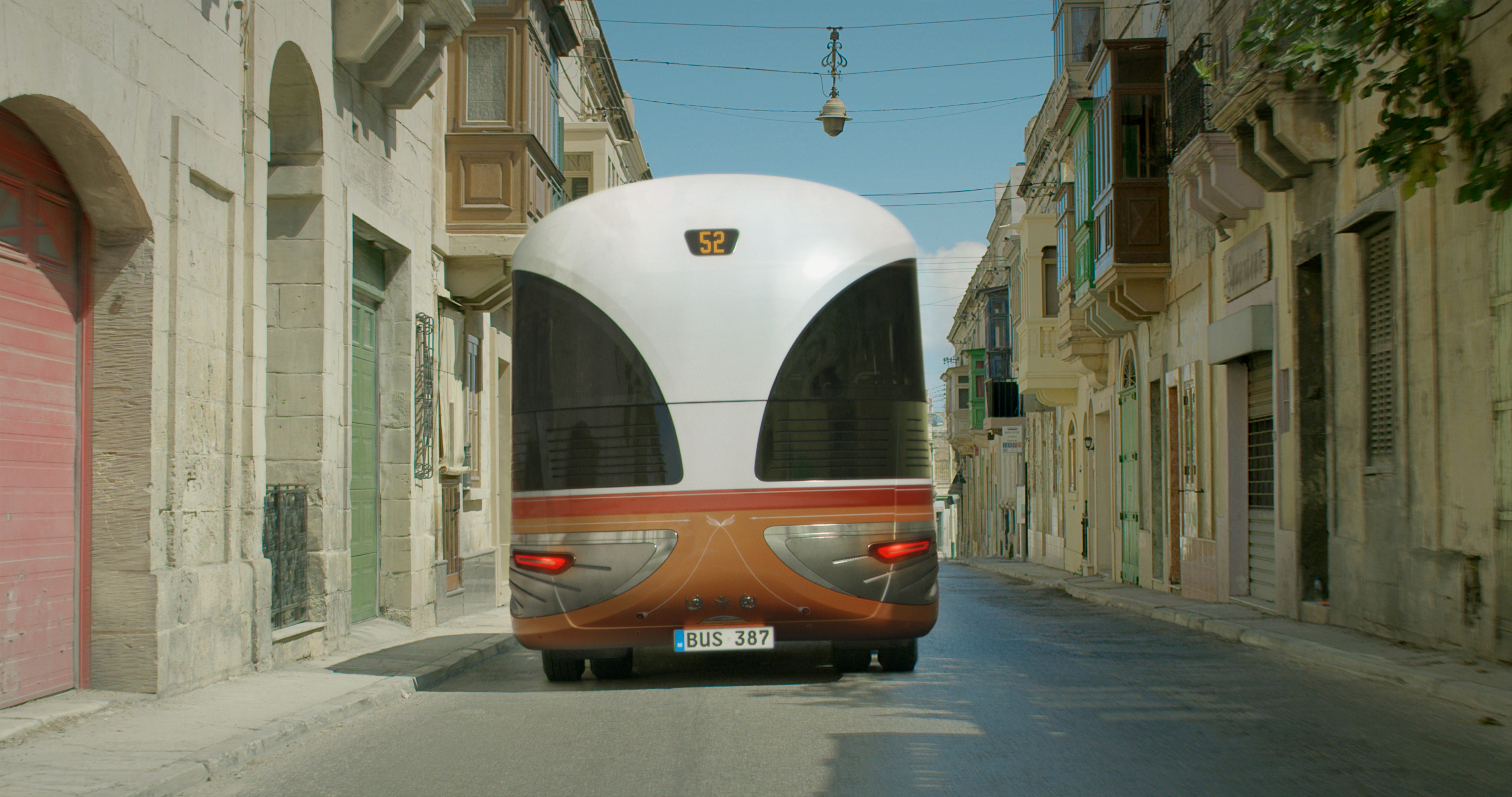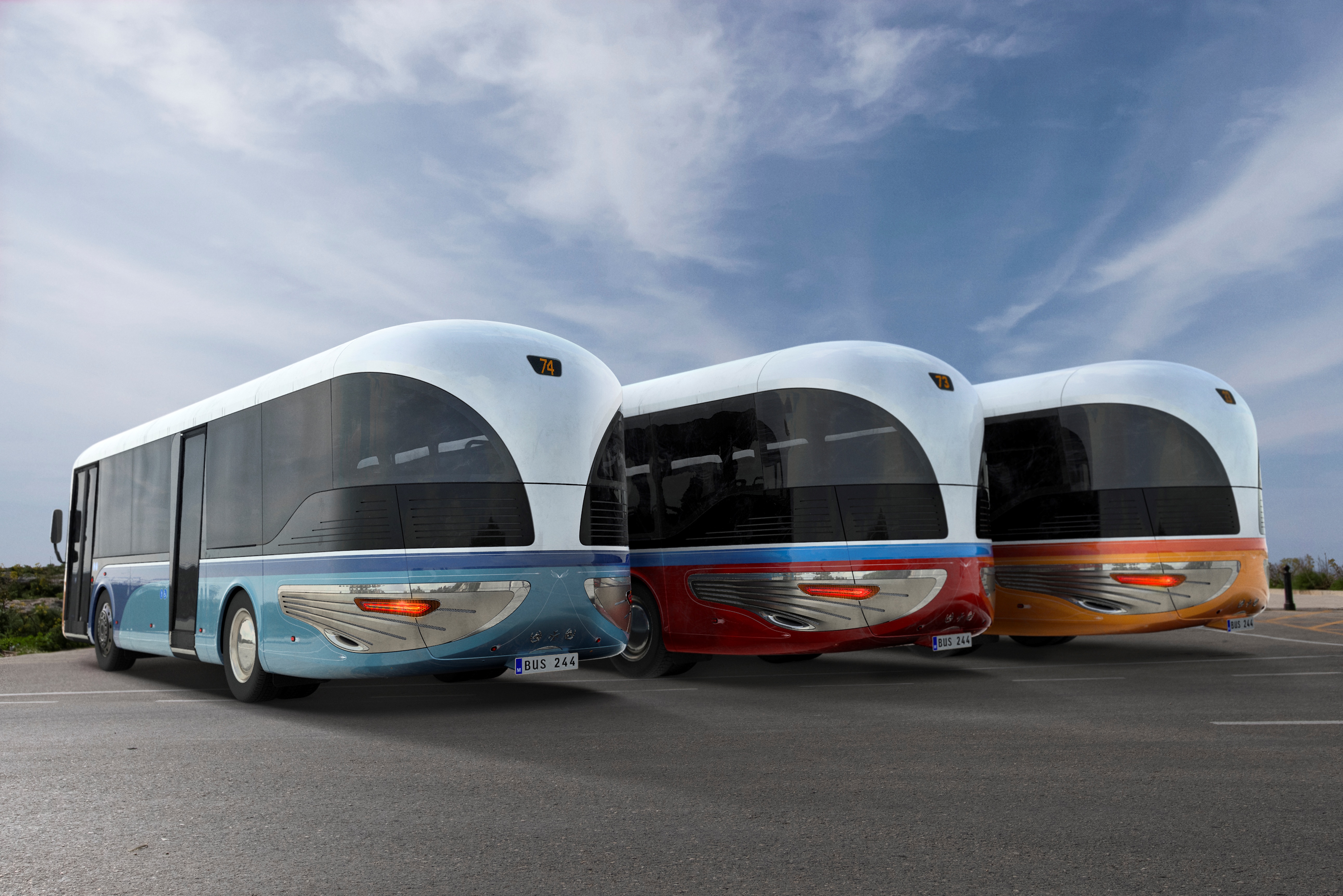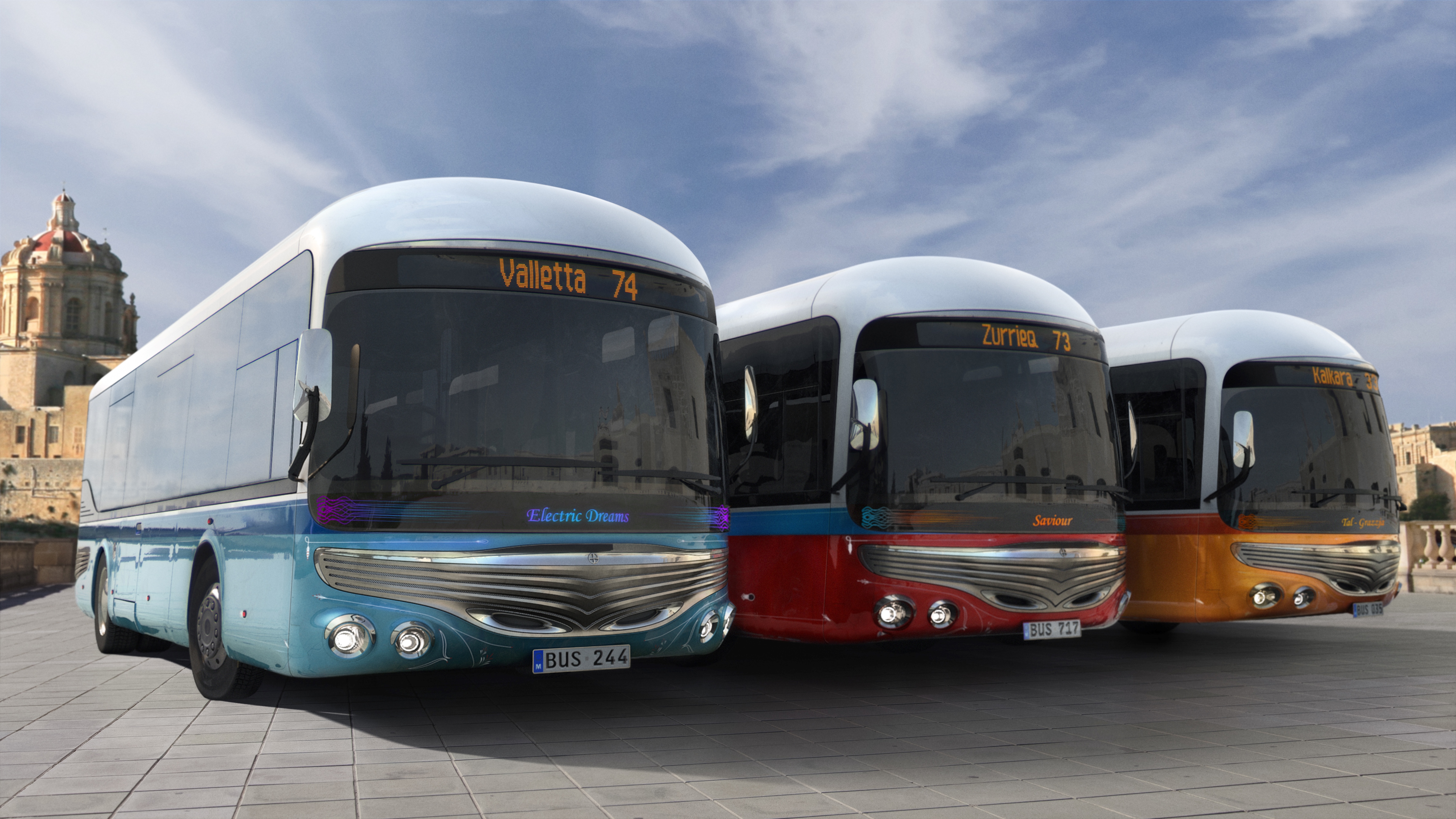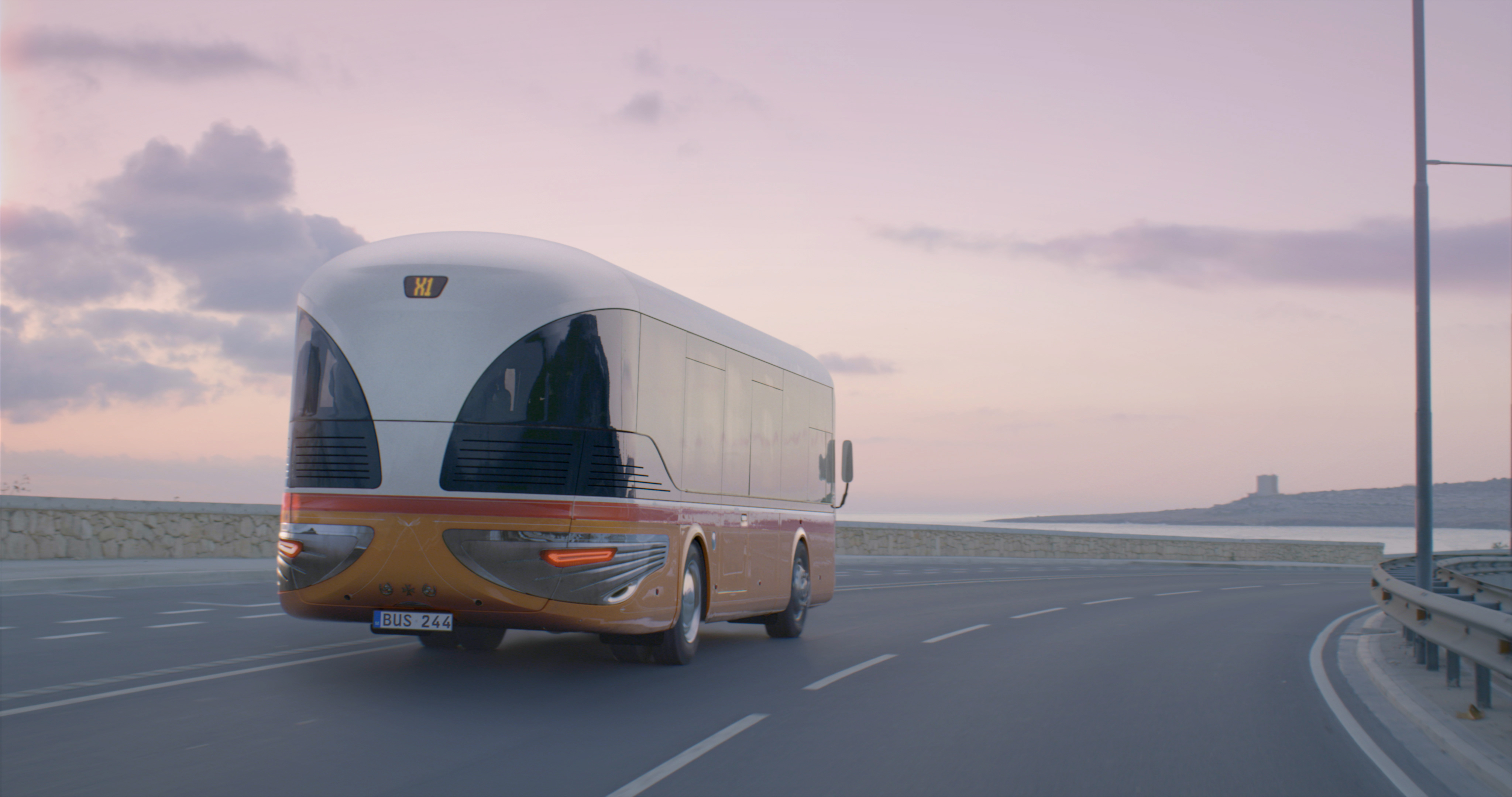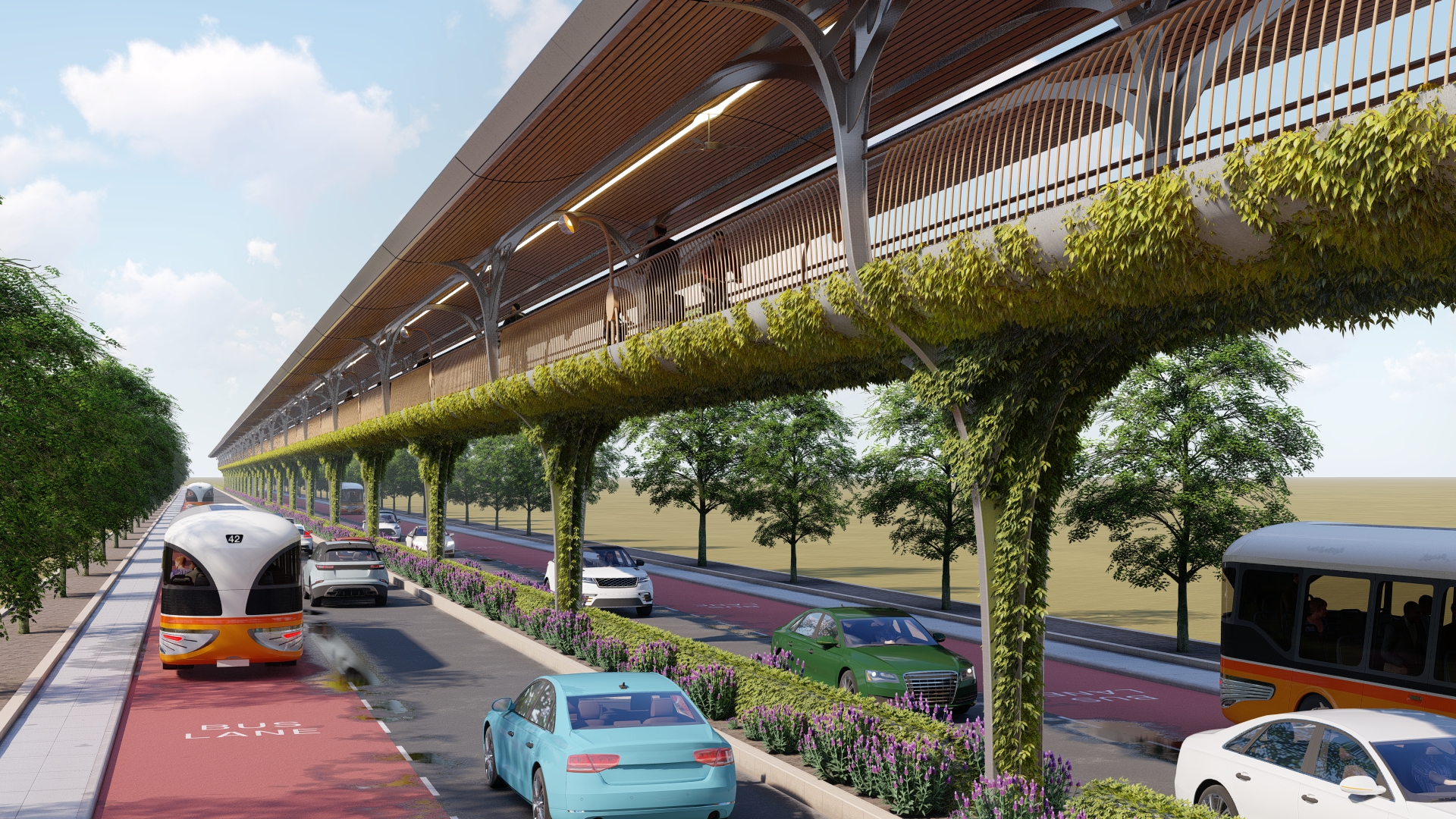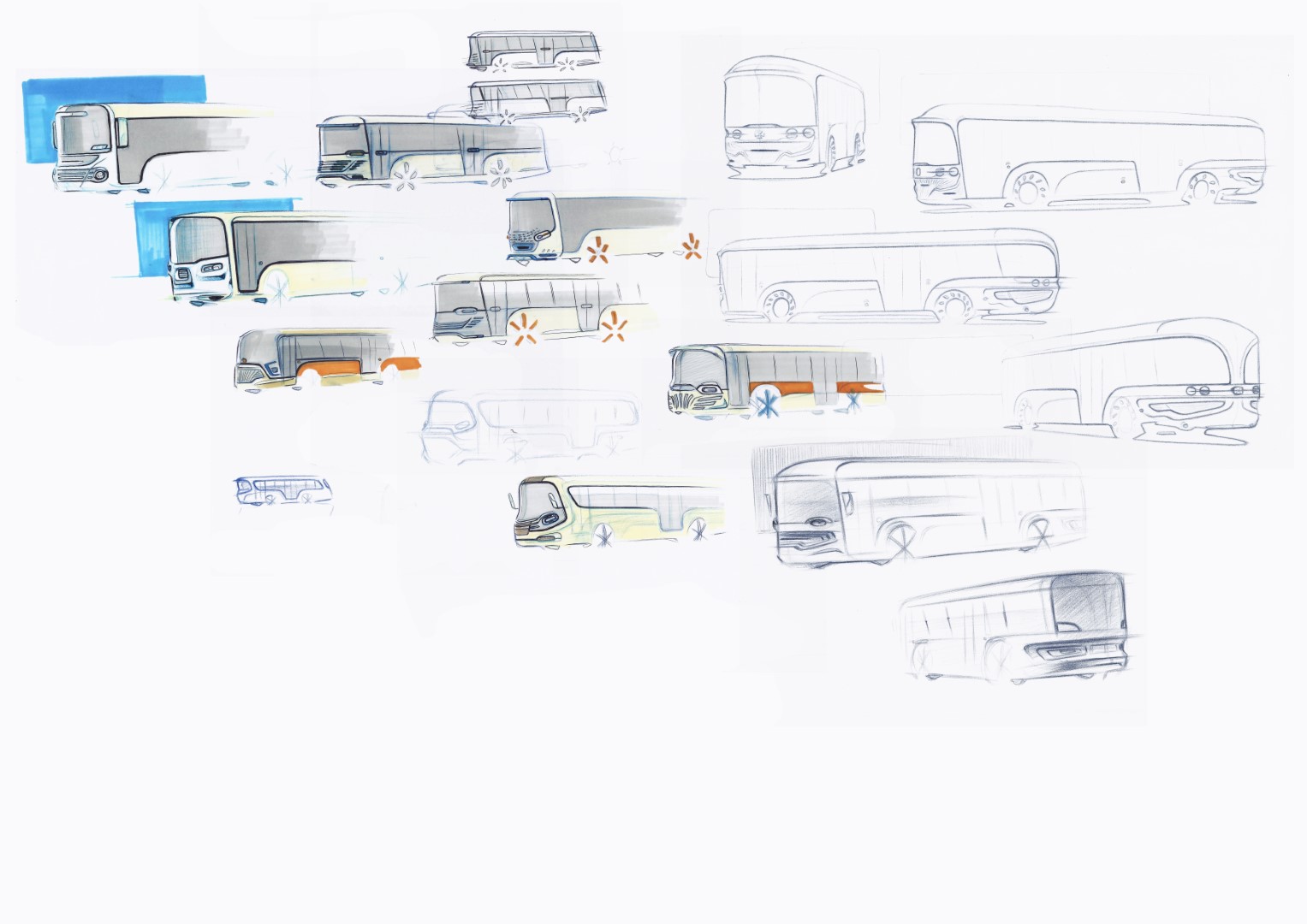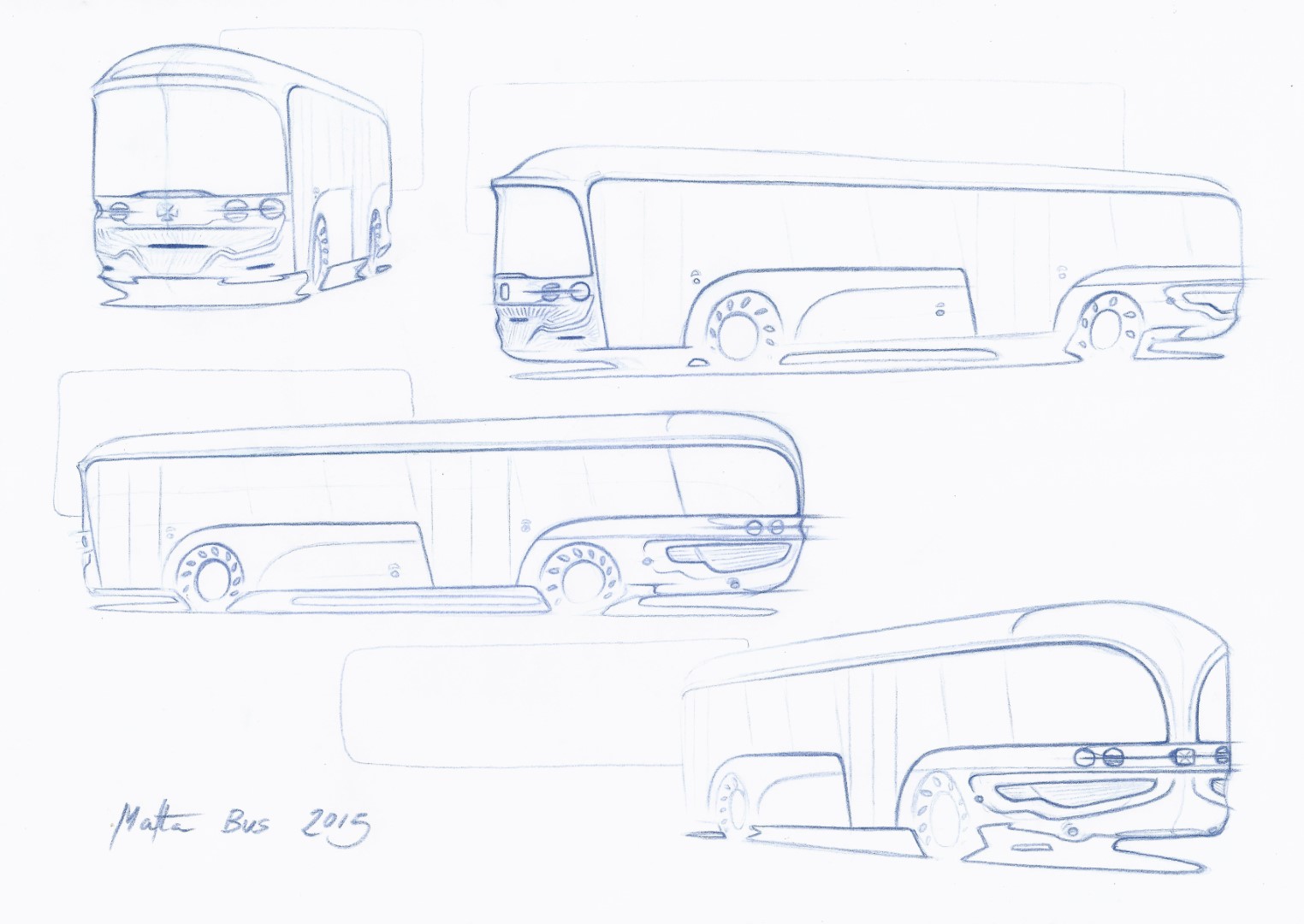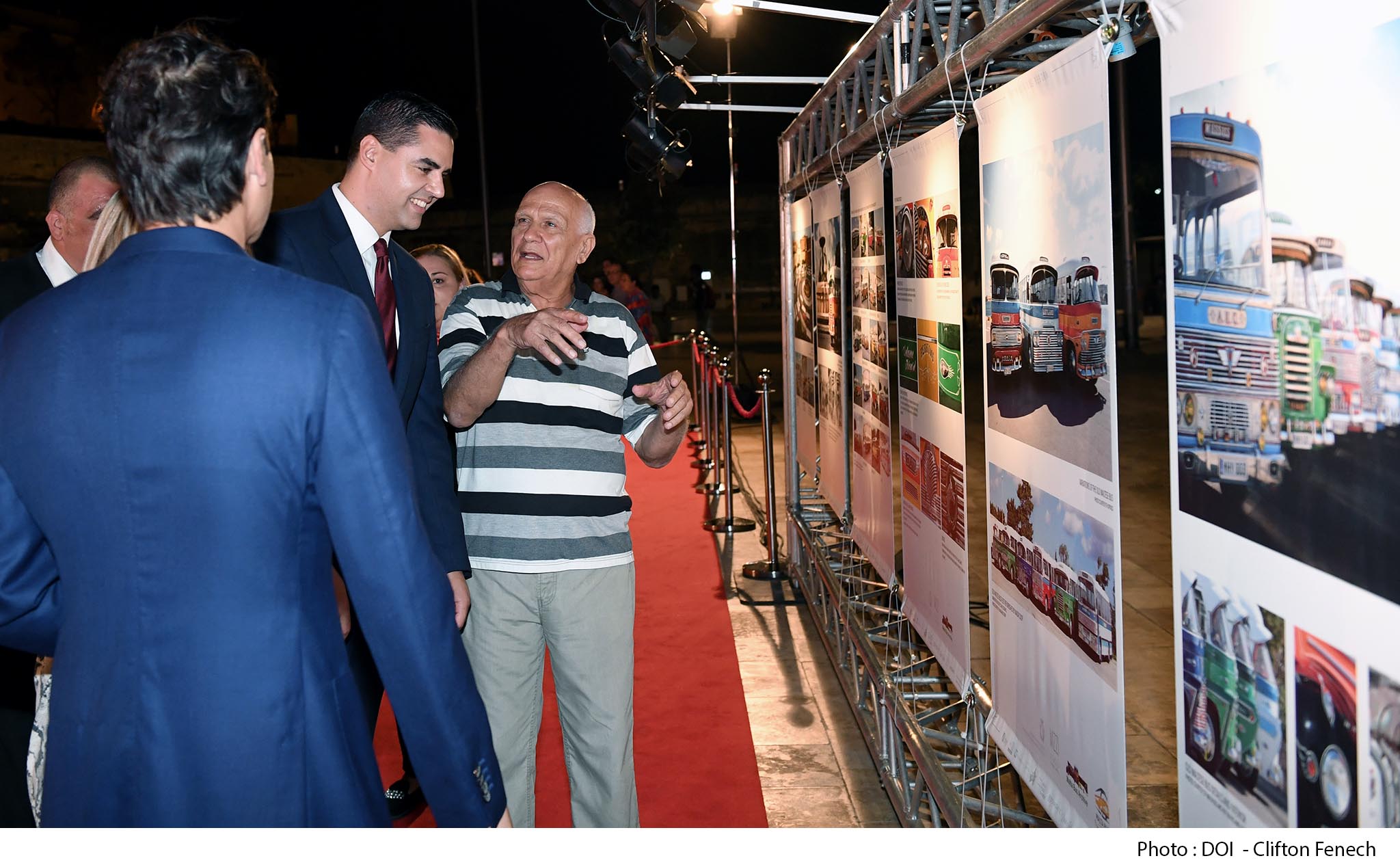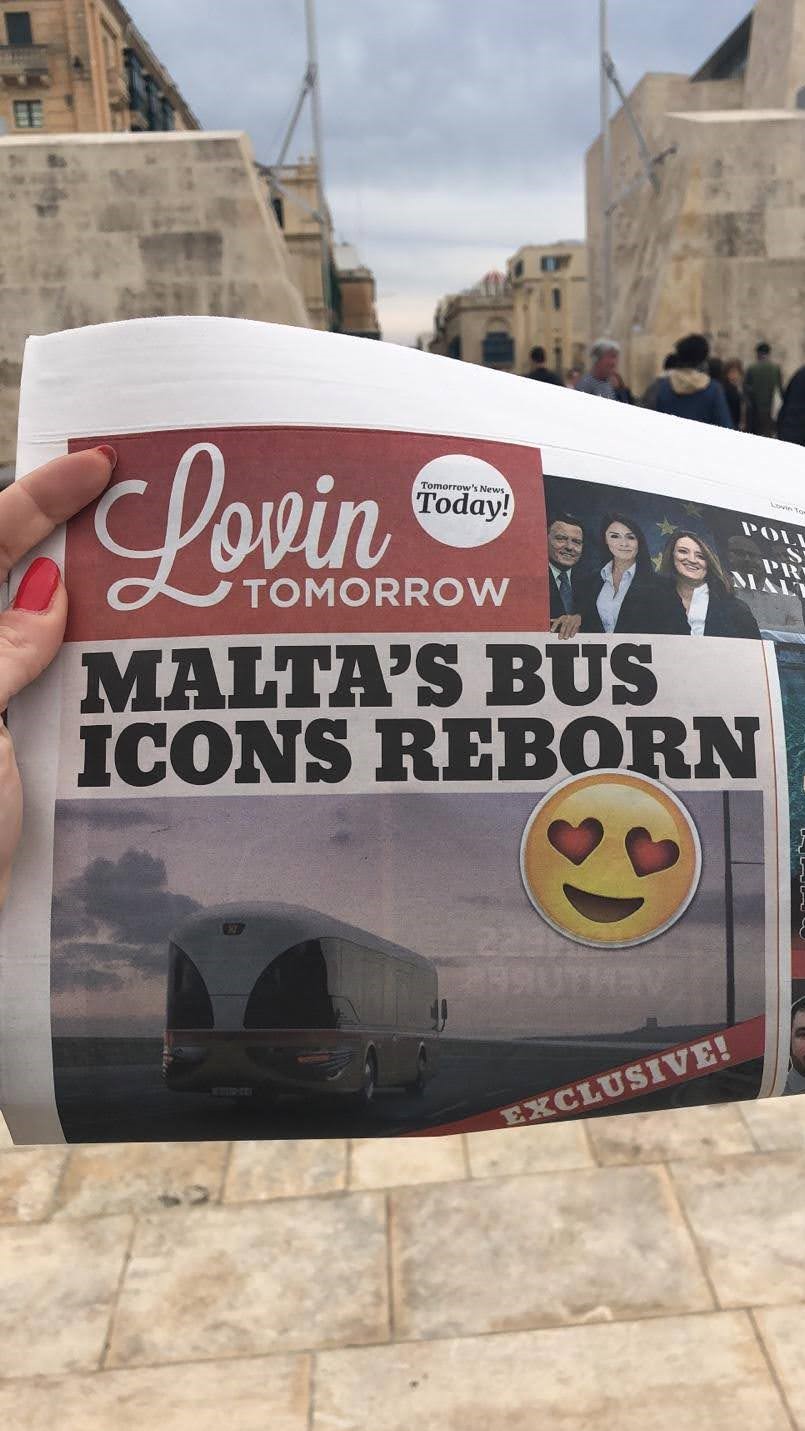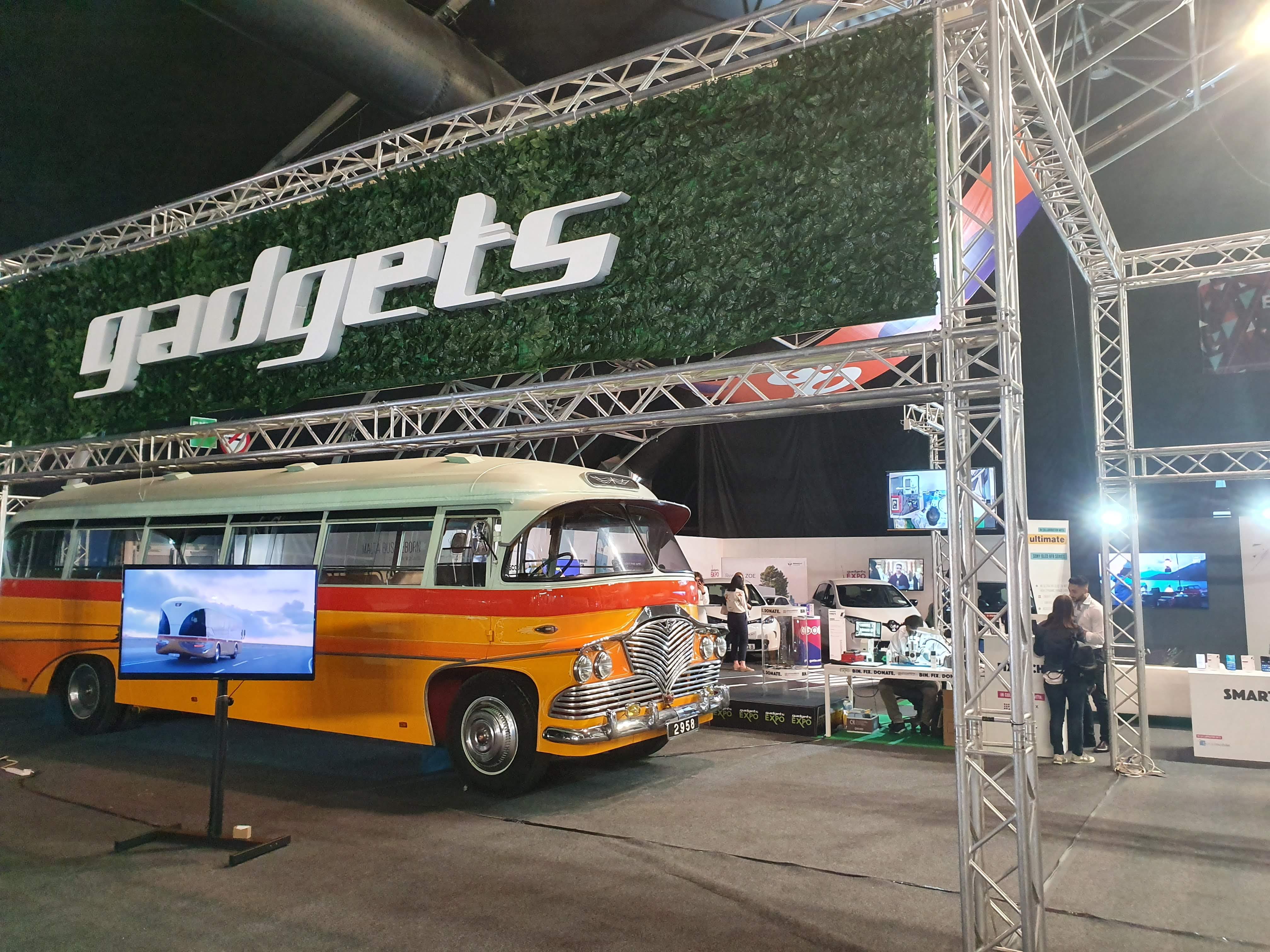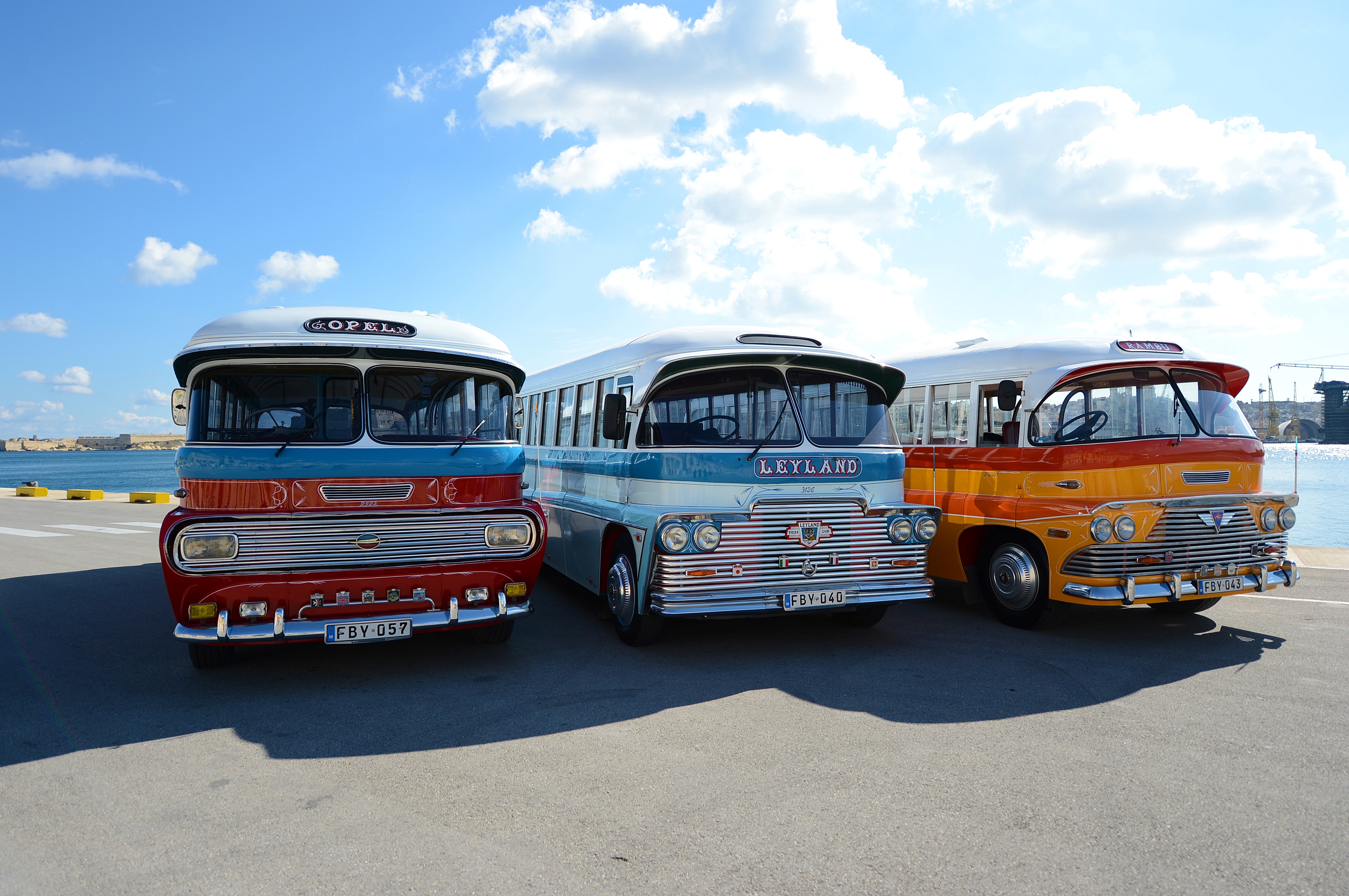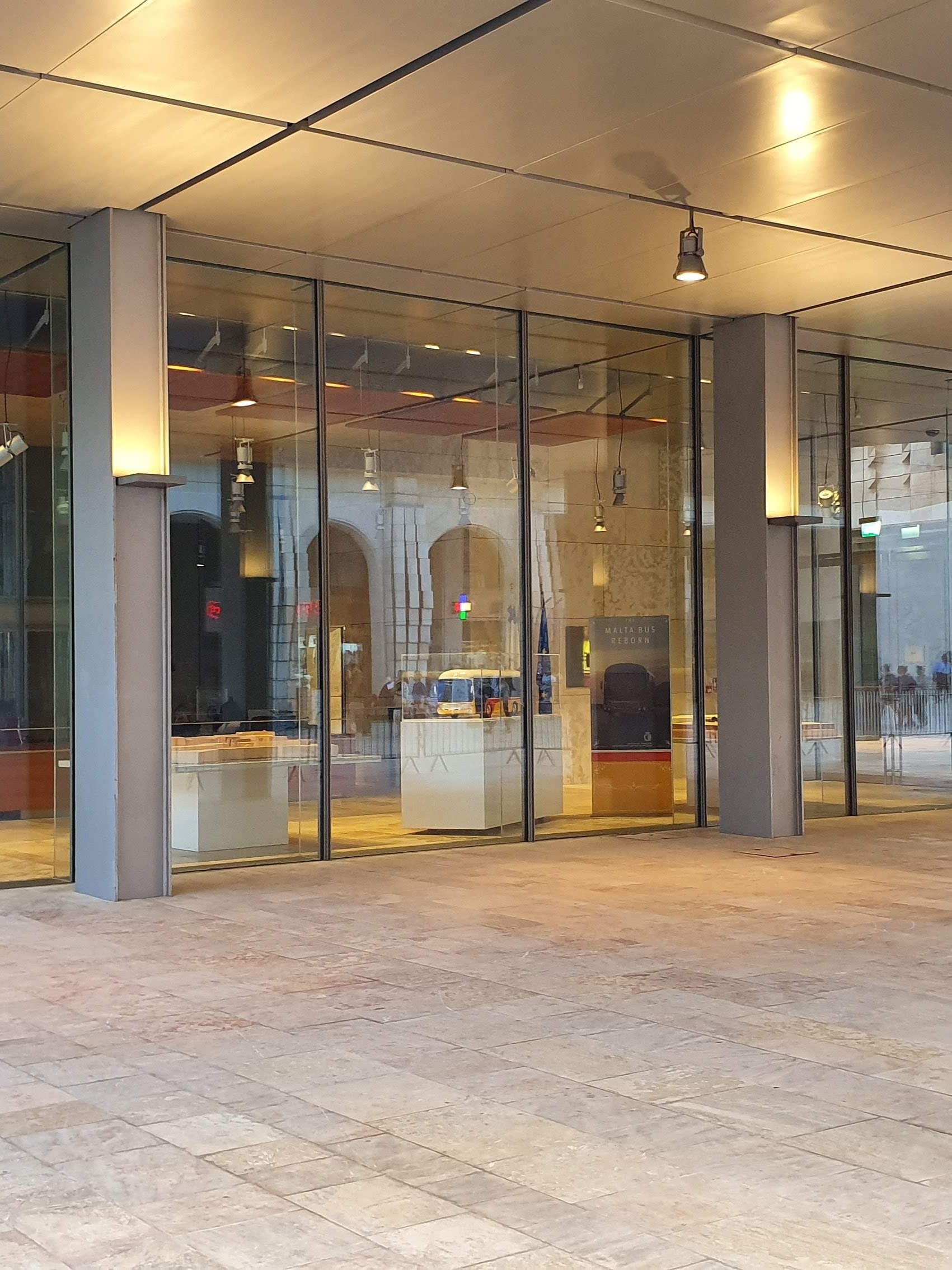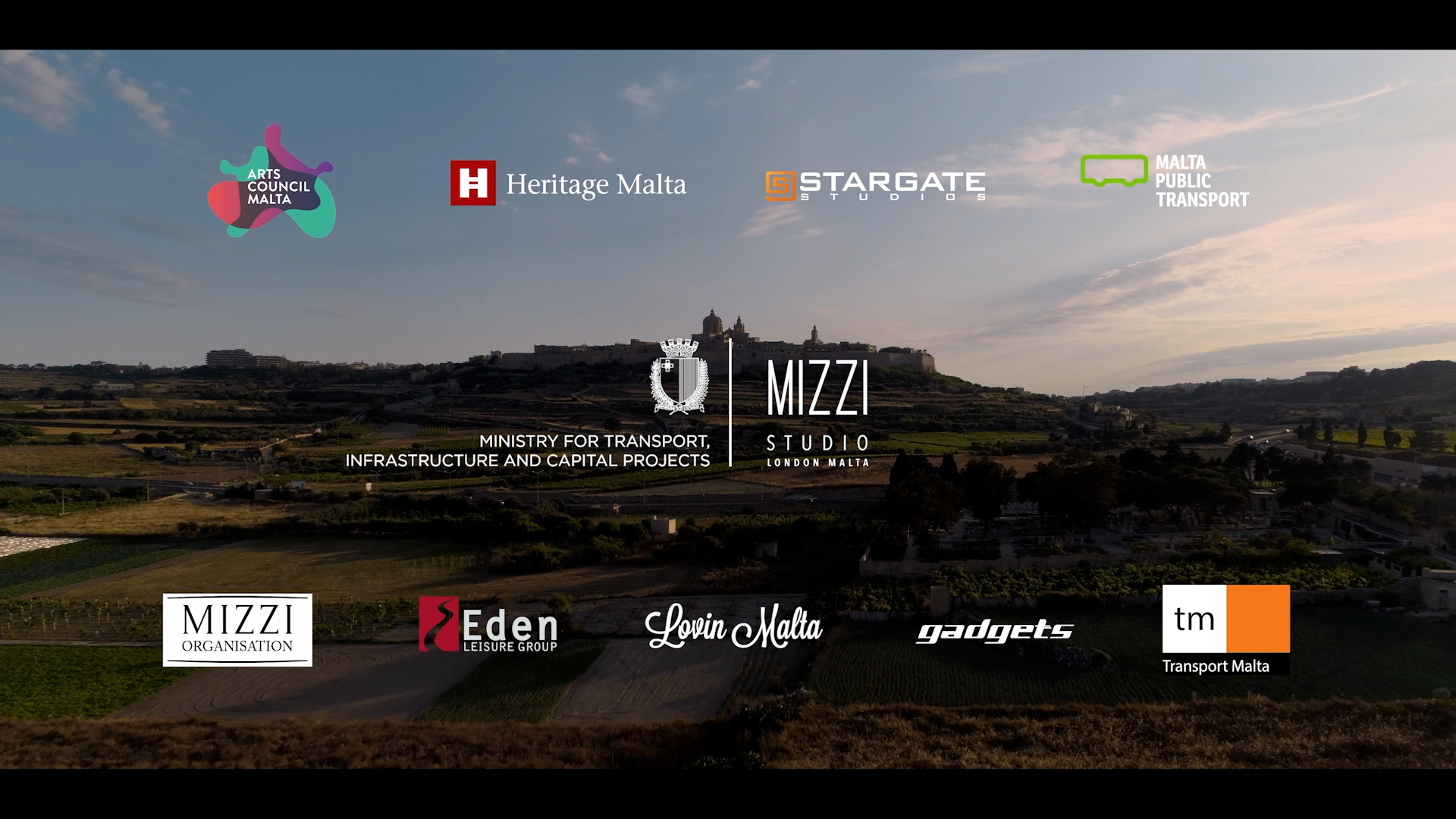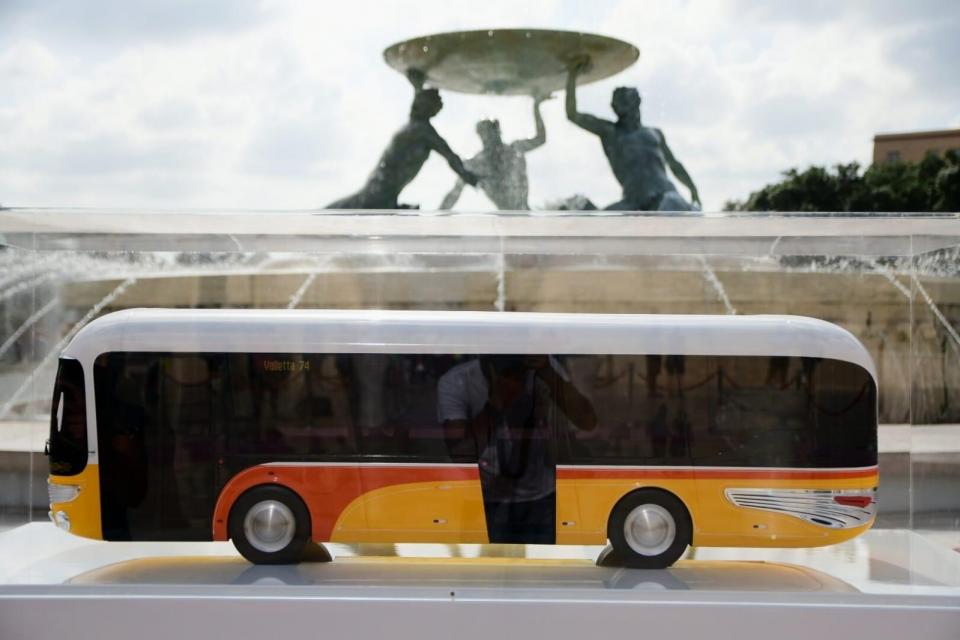Regaining a sense of belonging
The Malta Bus Reborn
The Malta Bus Reborn: Electrifying a cherished Heritage Icon.
The Malta Bus Reborn vision revived one of Malta's cultural icons, fusing heritage with climate action. The iconic diesel fleet, retired in 2011 due to environmental and accessibility issues, made a reimagined return to the public realm. A public campaign electrified the nation's imagination, securing an 86% poll vote of unprecedented citizen support. Reviving this national treasure is a rare opportunity to connect communities across Maltese islands through an environmental heritage initiative.
EU Member State, Western Balkans or Ukraine
Malta
National
No
No
It addresses urban-rural linkages
It refers to other types of transformations (soft investment)
Yes
2021-11-24
No
No
No
As a representative of an organisation
In 2019, Mizzi Studio unveiled designs for a new electric bus fleet for Malta, marrying zero-emissions technology with the charm of the iconic traditional Art-Deco Maltese buses. The project’s ethos aimed at reimagining a legacy design, restoring its heritage value and igniting new awareness around climate-resilient transport and net-zero mobility; placing culture and community at the heart of climate action.
The journey of the Malta Bus Reborn project has been multi-phased, beginning with years of extensive research on the history of Malta’s bus fleet – its design iterations, legacy features and their use until decommission. The project’s second phase was the rebirth through new designs that would replace Malta’s existing diesel fleet, whilst emulating their dynamic style. Mizzi Studio's proposal for a fully-electric, emissions-free fleet aligns with the EU's long-term strategy for a climate-neutral future and is designed for Malta's Mediterranean climate with net-zero powered cooling systems.
The third phase, a widespread awareness and engagement campaign, introduced the dream of a new bus to the Maltese public and integrated within the global conversation around transport and industrial design. To bring these ideas into the public imagination, a free exhibition was held in October 2019 at the entrance to Malta’s capital, Valletta. The exhibition showcased detailed steps of the design process, collaborative research and development with the Malta Bus Archive concluding with the final film screening. Throughout 2020 this was displayed at the Renzo Piano Parliament building and is now on permanent display at the Ministry of Transport. The project culminated in a lecture by Jonathan Mizzi on the TEDx University of Malta stage in 2021 with a speculative island-wide multi-modal transport system.
Fostering a sense of connection, the project revived an iconic gem that once held a daily presence across Malta, a unique conservation opportunity and heritage design.
The journey of the Malta Bus Reborn project has been multi-phased, beginning with years of extensive research on the history of Malta’s bus fleet – its design iterations, legacy features and their use until decommission. The project’s second phase was the rebirth through new designs that would replace Malta’s existing diesel fleet, whilst emulating their dynamic style. Mizzi Studio's proposal for a fully-electric, emissions-free fleet aligns with the EU's long-term strategy for a climate-neutral future and is designed for Malta's Mediterranean climate with net-zero powered cooling systems.
The third phase, a widespread awareness and engagement campaign, introduced the dream of a new bus to the Maltese public and integrated within the global conversation around transport and industrial design. To bring these ideas into the public imagination, a free exhibition was held in October 2019 at the entrance to Malta’s capital, Valletta. The exhibition showcased detailed steps of the design process, collaborative research and development with the Malta Bus Archive concluding with the final film screening. Throughout 2020 this was displayed at the Renzo Piano Parliament building and is now on permanent display at the Ministry of Transport. The project culminated in a lecture by Jonathan Mizzi on the TEDx University of Malta stage in 2021 with a speculative island-wide multi-modal transport system.
Fostering a sense of connection, the project revived an iconic gem that once held a daily presence across Malta, a unique conservation opportunity and heritage design.
National Icon
Climate Action
Culture and Innovation
Intergenerational Heritage
Conservational Design
Mizzi Studio’s research on the Malta Bus Reborn project drew inspiration from its international position, particularly London’s investment in transport heritage via Heatherwick Studio’s re-imagined Routemaster bus. Mizzi aimed to design a new Malta bus, instilling a renewed sense of pride while incorporating climate-driven features aligned with UN Sustainable Development Goals. This initiative targets Sustainable Cities and Communities(11), Climate Action(13), Affordable and Clean Energy(7), Industry, Innovation and Infrastructure(9) and contributes to Good Health and Well-Being(3).
In Malta’s economic progress, robust transport infrastructure is crucial, positioning the islands as net zero transport leaders. In recognising the substantial environmental impact of transport on quality of life, investments in transport links across the islands are vital for Malta’s future.
Malta buses have been the lifeblood of the islands’ transport infrastructure for over a century. Although Malta Public Transport has improved services, the 2011 demise of traditional buses resulted in a loss of cultural identity. The former buses were one of Malta’s most recognisable icons, beloved by tourists and locals. A new electric iteration of the classic icon would re-ignite that holistic cultural admiration, fortifying the long-term viability of its investment. Malta’s old buses were untenable pollutants, exacerbating air quality issues. The new Malta bus is a key player in achieving emissions targets, reducing private vehicles, and introducing net zero mobility into Malta’s transport narrative.
Electric buses are increasingly prevalent in European cities. New EU laws mandate that a quarter of buses purchased by European public authorities by 2025 must be climate-conscious, half being zero emission. Mizzi Studio’s proposed bus fleet ensures a positive environmental impact, being fully electric, emission-free, featuring a solar-powered roof and incorporating net zero cooling systems.
In Malta’s economic progress, robust transport infrastructure is crucial, positioning the islands as net zero transport leaders. In recognising the substantial environmental impact of transport on quality of life, investments in transport links across the islands are vital for Malta’s future.
Malta buses have been the lifeblood of the islands’ transport infrastructure for over a century. Although Malta Public Transport has improved services, the 2011 demise of traditional buses resulted in a loss of cultural identity. The former buses were one of Malta’s most recognisable icons, beloved by tourists and locals. A new electric iteration of the classic icon would re-ignite that holistic cultural admiration, fortifying the long-term viability of its investment. Malta’s old buses were untenable pollutants, exacerbating air quality issues. The new Malta bus is a key player in achieving emissions targets, reducing private vehicles, and introducing net zero mobility into Malta’s transport narrative.
Electric buses are increasingly prevalent in European cities. New EU laws mandate that a quarter of buses purchased by European public authorities by 2025 must be climate-conscious, half being zero emission. Mizzi Studio’s proposed bus fleet ensures a positive environmental impact, being fully electric, emission-free, featuring a solar-powered roof and incorporating net zero cooling systems.
Mizzi Studio’s multidisciplinary team set itself the design challenge of redefining Malta’s heritage bus, identifying strongest common features like the oversized smiling chrome grill, puppy dog-eyes of the round hooded headlights, hand-painted patterns and the overhanging visor. These were reinterpreted, with the new chrome bumper incorporating the traditional angel wing imagery for improved cooling. The design process integrated inherited elements onto a modern-day chassis, enhancing safety and comfort.
Extensive traditional research formed the basis for the new design’s evolution. The team unearthed textual and visual archival material, constructing a holistic narrative of the bus’s design legacy. The goal was to identify the shared DNA, capturing the essence of the diverse traditional buses that have evolved uniquely across time and localities, into a singular bus design.
Innovation at Mizzi Studio is synonymous with research. Historical and technical research powered the future-driven, sustainable design of the new Malta bus, with a multidisciplinary team, including automobile specialists with experience in vintage and contemporary vehicular projects.
Critical to the project’s transition from the design board to the public domain was experimental research, involving hands-on testing and prototyping. Refining a design for a vehicle evoking public affection, ensuring long-term durability and usability. Cutting-edge 3D and physical modelling played a foundational role in the new bus design’s development.
In parallel, the film unfolds the nostalgic journey of Joey Tat-Tberfil, the original artist responsible for pin-striping Maltese buses. Starting in the old bus graveyard, Joey envisions the return of the old Malta bus to the road. Transitioning to the contemporary Malta Bus Reborn, the film concludes with a poignant scene of Joey and his grandson on the bus, symbolising the enduring intergenerational pride and experiences tied to our local heritage.
Extensive traditional research formed the basis for the new design’s evolution. The team unearthed textual and visual archival material, constructing a holistic narrative of the bus’s design legacy. The goal was to identify the shared DNA, capturing the essence of the diverse traditional buses that have evolved uniquely across time and localities, into a singular bus design.
Innovation at Mizzi Studio is synonymous with research. Historical and technical research powered the future-driven, sustainable design of the new Malta bus, with a multidisciplinary team, including automobile specialists with experience in vintage and contemporary vehicular projects.
Critical to the project’s transition from the design board to the public domain was experimental research, involving hands-on testing and prototyping. Refining a design for a vehicle evoking public affection, ensuring long-term durability and usability. Cutting-edge 3D and physical modelling played a foundational role in the new bus design’s development.
In parallel, the film unfolds the nostalgic journey of Joey Tat-Tberfil, the original artist responsible for pin-striping Maltese buses. Starting in the old bus graveyard, Joey envisions the return of the old Malta bus to the road. Transitioning to the contemporary Malta Bus Reborn, the film concludes with a poignant scene of Joey and his grandson on the bus, symbolising the enduring intergenerational pride and experiences tied to our local heritage.
Malta Bus Reborn project aimed to blend design with awareness and knowledge sharing, achieving significant public engagement through various channels. Widely covered in popular culture, news, and lifestyle media, the initiative reached diverse audiences.
Highlights include:
- Featured in Malta’s most-watched television shows, including TVAM & TVM News (123,000 viewers) and Xarabank (69,000 viewers).
- Widespread coverage across Malta’s news outlets including Times of Malta, Malta Today, Malta Independent and Lovin Malta.
- Shared by leading lifestyle and design press including Forbes (6.4m readers), Wallpaper* (2m readers), and Designboom (3.5m readers), as well as media across Europe, Mexico, Japan and China.
- Front cover feature of Lovin Malta's exclusive print newspaper (25,000 printed).
- Re-shared as a major component of Mizzi Studio’s proposal for a green, multi-modal transport overhaul, presented in a TEDx University of Malta talk titled, ‘Designing Humanity Out of a Climate Crisis’.
The Malta Bus Reborn project actively engaged the Maltese public, aligning with its broader goal to unite cultural heritage dedication with climate action awareness education. The design prioritised easy accessibility, featuring middle doors and low floors to facilitate efficient boarding and disembarking.
The close collaboration with the old bus-driver communities, the Malta Bus Archive, and traditional pin-striping artist Joey ‘tat-Tberfil’ underscored the project’s commitment to community engagement and recognizing the impact of these independent figures on the collective experience of the bus system. The freely accessible exhibition near Valletta’s city gate entrance contributed to its inherently public nature. Focused on the island’s public transport system, the project garnered the support of the Minister of Transport, Infrastructure and Capital Projects, initiating discussions about potential implementation within the infrastructural system.
Highlights include:
- Featured in Malta’s most-watched television shows, including TVAM & TVM News (123,000 viewers) and Xarabank (69,000 viewers).
- Widespread coverage across Malta’s news outlets including Times of Malta, Malta Today, Malta Independent and Lovin Malta.
- Shared by leading lifestyle and design press including Forbes (6.4m readers), Wallpaper* (2m readers), and Designboom (3.5m readers), as well as media across Europe, Mexico, Japan and China.
- Front cover feature of Lovin Malta's exclusive print newspaper (25,000 printed).
- Re-shared as a major component of Mizzi Studio’s proposal for a green, multi-modal transport overhaul, presented in a TEDx University of Malta talk titled, ‘Designing Humanity Out of a Climate Crisis’.
The Malta Bus Reborn project actively engaged the Maltese public, aligning with its broader goal to unite cultural heritage dedication with climate action awareness education. The design prioritised easy accessibility, featuring middle doors and low floors to facilitate efficient boarding and disembarking.
The close collaboration with the old bus-driver communities, the Malta Bus Archive, and traditional pin-striping artist Joey ‘tat-Tberfil’ underscored the project’s commitment to community engagement and recognizing the impact of these independent figures on the collective experience of the bus system. The freely accessible exhibition near Valletta’s city gate entrance contributed to its inherently public nature. Focused on the island’s public transport system, the project garnered the support of the Minister of Transport, Infrastructure and Capital Projects, initiating discussions about potential implementation within the infrastructural system.
The Malta Bus Reborn project saw significant engagement from the Maltese public. The project’s ambition was to combine an inherent national dedication to cultural heritage with new energy towards climate action awareness and education. To do so, the project employed several engagement initiatives – both digital and physical – to ensure uptake from audiences throughout all stages of the project’s lifespan. When surveyed by news and media platform, Lovin Malta, 86% of the Maltese public said they ‘loved’ the new buses. 15K total likes, comments, and shares on Facebook and a further 2.5k across Instagram and Twitter were garnered towards the project. More than 200,000 people watched the teaser videos on Mizzi Studio, Lovin Malta and Xarabank’s channels alone. 4K likes, comments, and shares were gained across Mizzi Studio’s social media channels. The Malta Bus Reborn exhibition welcomed an abundant crowd, with the Minister for Transport in attendance to inaugurate.
Joey Tat-Tberfil, a cursive pattern artist for the original bus fleet, starred in the Malta Bus Reborn film. The film was a catalyst for uniting the old and new Malta bus worlds, reflecting the design team’s desire to re-ignite the nation’s love of decoration, to reassess its value in traditional craft, and to promote the needs of its diverse communities. Joey also collaborated with Mizzi Studio designers on decorative panels created for the Valletta exhibition. The exhibition re-introduced audiences to Malta’s traditional, driver-owned buses – focusing specifically on the historic autonomy of drivers and bus owner communities. Our partners, Lovin Malta, with 280,000 followers, represent the first local social media news channel with a young millennial and Gen Z journalistic team. This has enabled our narrative to resonate with today's youth. Furthermore, working with the talented VFX artists at Stargates Studio, pushing them to new heights and showcasing their works locally.
Joey Tat-Tberfil, a cursive pattern artist for the original bus fleet, starred in the Malta Bus Reborn film. The film was a catalyst for uniting the old and new Malta bus worlds, reflecting the design team’s desire to re-ignite the nation’s love of decoration, to reassess its value in traditional craft, and to promote the needs of its diverse communities. Joey also collaborated with Mizzi Studio designers on decorative panels created for the Valletta exhibition. The exhibition re-introduced audiences to Malta’s traditional, driver-owned buses – focusing specifically on the historic autonomy of drivers and bus owner communities. Our partners, Lovin Malta, with 280,000 followers, represent the first local social media news channel with a young millennial and Gen Z journalistic team. This has enabled our narrative to resonate with today's youth. Furthermore, working with the talented VFX artists at Stargates Studio, pushing them to new heights and showcasing their works locally.
The Malta Bus Reborn project bridged public and private stakeholders involvement at local, regional and national levels, engaging the Ministry of Transport in conducting feasibility studies through their alignment. This initiative fostered cultural pride, intercultural dialogues, and diversity at a community level. The design sparked significant interest from both the public and industry press. Internationally, the new Malta bus was shared by leading lifestyle and design press including: Forbes (6.4m readers), Wallpaper* (2m readers), and Designboom (3.5m readers); as well as media across Europe, Mexico, Japan and China.
The project garnered support from Malta’s most significant industrial, transport and cultural heritage stakeholders. The project secured €10,000 in initial seed funding through Arts Council Malta’s Project Support Grant, with an additional €5,000 from Transport Malta. Alongside this, the project received substantial in-kind contributions from various supporters, including Eden Leisure Cinema feature of the Malta Bus Reborn film in a 6-month video showcase preceding all feature films. Heritage Malta provided access to the remaining bus fleet for potential future restoration and offered Triton Square in Valletta for the project launch event, Malta Public Transport contributed buses for the live-action film production, Lovin Malta as a media partner and Gadgets who supported the Malta Technological Expo. These combined belief in the project characterised an unprecedented collective championing on the islands.
Furthermore, Film Production and VFX Studio, Stargate Studios generously undertook the project at a reduced cost of €40,000 which the Ministry for Transport, Infrastructure, and Capital Projects funding providing €64,000 for the event and film production, instrumental in launching the Valletta exhibition and ongoing continuation of the project development to implementation.
The project garnered support from Malta’s most significant industrial, transport and cultural heritage stakeholders. The project secured €10,000 in initial seed funding through Arts Council Malta’s Project Support Grant, with an additional €5,000 from Transport Malta. Alongside this, the project received substantial in-kind contributions from various supporters, including Eden Leisure Cinema feature of the Malta Bus Reborn film in a 6-month video showcase preceding all feature films. Heritage Malta provided access to the remaining bus fleet for potential future restoration and offered Triton Square in Valletta for the project launch event, Malta Public Transport contributed buses for the live-action film production, Lovin Malta as a media partner and Gadgets who supported the Malta Technological Expo. These combined belief in the project characterised an unprecedented collective championing on the islands.
Furthermore, Film Production and VFX Studio, Stargate Studios generously undertook the project at a reduced cost of €40,000 which the Ministry for Transport, Infrastructure, and Capital Projects funding providing €64,000 for the event and film production, instrumental in launching the Valletta exhibition and ongoing continuation of the project development to implementation.
The design of the contemporary Malta Bus reflects a fusion of disciplines and knowledge fields, exemplifying the Mizzi Studio team’s commitment to innovation through thorough research. Historical and technical research has thus powered the future-driven, sustainable design. To support these intentions, the team has been made up of multidisciplinary designers including architects and automobile specialists who have worked on several vintage and contemporary vehicular projects. The collaborative effort extends to VFX specialists at Stargate Studio, who worked on the final film, seamlessly integrating design elements implemented by Mizzi Studio’s architectural and automobile designers.
This interdisciplinary collaboration was an ongoing process, involving organisations like the Malta Bus Archive and Malta Bus Coop for archival research, craftsman Joey Tat-Tberfil’s pin-striping showcased in the exhibition, and a partnership with Eden Leisure for an extended film screening in their cinemas. The project spans various phases, with contributions from photographers, visual effects artists, production managers and illustrators, showcasing the dynamic interaction between diverse fields in the creation of a contemporary transportation icon.
This interdisciplinary collaboration was an ongoing process, involving organisations like the Malta Bus Archive and Malta Bus Coop for archival research, craftsman Joey Tat-Tberfil’s pin-striping showcased in the exhibition, and a partnership with Eden Leisure for an extended film screening in their cinemas. The project spans various phases, with contributions from photographers, visual effects artists, production managers and illustrators, showcasing the dynamic interaction between diverse fields in the creation of a contemporary transportation icon.
The field of vehicular design is ever-evolving. This project marries its sector-specific innovation with the world of cultural heritage. Technology has been instrumental to propelling the original design qualities of the classic Malta bus into the future. The utilisation of composite moulding in digital manufacturing enables the aerodynamic design of the bus, whilst, digital design has allowed the Mizzi Studio team to revive the bus’s hand-painted pinstriping, known as ‘tberfil’. This reintroduces personalised slogans and patterns into LED lighting strips, accentuating the bus's attractive features, like painted eyelashes highlighting the vehicles' inherent contours. Digital 'tberfil' empowers drivers to customise their vehicles once again, reintroducing charming phrases from old traditions, like 'Saviour,' 'Elvis Presley,' or 'Ave Maria,' in ornamental cursive script through LED technology. The project’s innovation lies with uniting three things: cultural heritage, digital design flair and climate action. This fusion along with the collaboration over the years with multiple organisations and professionals has allowed the project to take on a unique action with the public interest, sustainability and national identity at the heart of it.
As outlined, the Malta Bus Reborn project began with an extensive research and design phase. This enabled the team to put its best foot forward in bringing a vision to the public that married cultural heritage with a strategy for climate-conscious mobility.
Following the refinement of the design, Mizzi Studio delivered the Malta Bus Reborn project through the following stages of implementation:
1. Launching a media endeavour with the aim of re-kindling collective appetite for vast improvement within national public transport. Mizzi Studio partnered with a leading local news platform to roll out this campaign, including a survey that polled the Maltese public’s enthusiasm for the project.
2. Opening a free public exhibition at the site of the Triton Fountain in Valletta, including a 1:6 scale model of the proposed bus, and a five-minute aspirational film produced by Stargate Studios, picturing the new bus on routes through some of the islands’ most picturesque locations.
3. Proliferating the Malta Bus reborn film beyond the exhibition, in cinemas and across local media, in tandem with an ongoing international press push.
4. Growing the ambition of the new Malta Bus into a broader awareness campaign around multi-modal transport in Malta. A far-reaching TEDx talk became the launchpad to introduce the Canopy Tree Line – a transport system using elevated bicycle routes on existing main roads, alleviating cars from highways and returning driving space back to public buses.
Following the refinement of the design, Mizzi Studio delivered the Malta Bus Reborn project through the following stages of implementation:
1. Launching a media endeavour with the aim of re-kindling collective appetite for vast improvement within national public transport. Mizzi Studio partnered with a leading local news platform to roll out this campaign, including a survey that polled the Maltese public’s enthusiasm for the project.
2. Opening a free public exhibition at the site of the Triton Fountain in Valletta, including a 1:6 scale model of the proposed bus, and a five-minute aspirational film produced by Stargate Studios, picturing the new bus on routes through some of the islands’ most picturesque locations.
3. Proliferating the Malta Bus reborn film beyond the exhibition, in cinemas and across local media, in tandem with an ongoing international press push.
4. Growing the ambition of the new Malta Bus into a broader awareness campaign around multi-modal transport in Malta. A far-reaching TEDx talk became the launchpad to introduce the Canopy Tree Line – a transport system using elevated bicycle routes on existing main roads, alleviating cars from highways and returning driving space back to public buses.
Sustainability in transport is a pillar of the European identity, symbolising Europe’s commitment to environmental stewardship and its potential mutuality with economic growth. Sustainable transport serves as a catalyst for positive environmental change through the reduction of greenhouse gas emissions, through the combatting of climate change and improvement of air quality, and through the overall enhancement of public health. Sustainable transport stands to boost energy security by diminishing reliance on fossil fuels, fostering clean technology innovation, and generating employment. For all of these reasons, the Malta Bus Reborn project and its core intention to introduce sustainable transport onto Malta’s roads acts as an emblem of innovation and environmental responsibility. This in turn echoes European values of collaboration, advancement, and ecological stewardship.
During a TEDx presentation at the University of Malta, Mizzi Studios presented a comprehensive eco-driven multi-modal transport strategy for a future-facing Malta. In a bid to reduce privately owned cars on the Maltese roads, the Malta Bus 8 of 14 European and international dimension Costs of the project/initiative Reborn would join other transport alternatives including elevated cycling canopy lanes, scooting, and walking. The infrastructural proposal included a Rapid Bus Transport System, creating an exclusive right-of-way path giving access to buses across all arterial roads on the islands. There are currently approximately 420,000 cars on Malta’s roads. For every bus used at full capacity, 40 cars would be removed from Malta’s roads. Furthermore, there are several iconic buses (and other industrial heritage) around the world that are facing the same fate of being decommissioned due to environmental, accessibility and safety concerns. This project represents translatable industrial and climate-forward heritage that can be replicated as a concept in a culturally relevant way.
During a TEDx presentation at the University of Malta, Mizzi Studios presented a comprehensive eco-driven multi-modal transport strategy for a future-facing Malta. In a bid to reduce privately owned cars on the Maltese roads, the Malta Bus 8 of 14 European and international dimension Costs of the project/initiative Reborn would join other transport alternatives including elevated cycling canopy lanes, scooting, and walking. The infrastructural proposal included a Rapid Bus Transport System, creating an exclusive right-of-way path giving access to buses across all arterial roads on the islands. There are currently approximately 420,000 cars on Malta’s roads. For every bus used at full capacity, 40 cars would be removed from Malta’s roads. Furthermore, there are several iconic buses (and other industrial heritage) around the world that are facing the same fate of being decommissioned due to environmental, accessibility and safety concerns. This project represents translatable industrial and climate-forward heritage that can be replicated as a concept in a culturally relevant way.
The pervasive pollution from ageing diesel buses poses a significant global challenge, prompting European nations to mandate the transition to electric public transport amid climate change. The worldwide challenge of ensuring accessible and efficient public transport for all persists, with shifts to electric fleets offering numerous environmental benefits.
Encouragingly, the adoption of electric buses contributes to reducing air pollution and greenhouse gas emissions, aligning with global efforts to combat climate change. However, as we advance toward environmentally conscious, zero-emission transport systems, it is crucial to safeguard the unique character and historical significance of national icons. The challenge lies in balancing the essential need for cleaner, more efficient electric public transport with the preservation of the cultural and historical heritage of national treasures.
Moreover, the transition to the electric fleets present an opportunity to pay homage to the traditional craft and skills integral to the production and charm of iconic buses. These age-old methods, often passed down through generations, are valuable cultural assets at risk of fading into obscurity with the phasing out of our traditional fleet. Embracing the future of electric mobility necessitates preserving these artisanal skills. Initiatives that seek to recreate a contemporary take on the craftsmanship associated with the Malta Bus not only preserve the legacy of skilled artisans but also facilitate their transition into more modern design systems, fostering a seamless blend of tradition and innovation.
The shift to electric public transport is a global imperative to combat pollution and enhance accessibility. As this transition unfolds, it is vital to harmonise progress with preservation of cultural heritage, ensuring that the journey toward environmentally conscious systems is both forward-looking and respectful of the unique character of local identities.
Encouragingly, the adoption of electric buses contributes to reducing air pollution and greenhouse gas emissions, aligning with global efforts to combat climate change. However, as we advance toward environmentally conscious, zero-emission transport systems, it is crucial to safeguard the unique character and historical significance of national icons. The challenge lies in balancing the essential need for cleaner, more efficient electric public transport with the preservation of the cultural and historical heritage of national treasures.
Moreover, the transition to the electric fleets present an opportunity to pay homage to the traditional craft and skills integral to the production and charm of iconic buses. These age-old methods, often passed down through generations, are valuable cultural assets at risk of fading into obscurity with the phasing out of our traditional fleet. Embracing the future of electric mobility necessitates preserving these artisanal skills. Initiatives that seek to recreate a contemporary take on the craftsmanship associated with the Malta Bus not only preserve the legacy of skilled artisans but also facilitate their transition into more modern design systems, fostering a seamless blend of tradition and innovation.
The shift to electric public transport is a global imperative to combat pollution and enhance accessibility. As this transition unfolds, it is vital to harmonise progress with preservation of cultural heritage, ensuring that the journey toward environmentally conscious systems is both forward-looking and respectful of the unique character of local identities.
In its ambition to preserve and enhance the islands’ industrial design legacy, the Malta Bus Reborn ignited widespread awareness around net-zero mobility. Key achievements over the past three years include:
A Swell of Public Interest:
More than 200,000 people watched the teaser videos on Mizzi Studio, Lovin Malta and local talk show channels, with additional viewings as the film was showcased at the islands’ premier cinema chain before all feature screenings. The new Malta Bus garnered 30K total likes, comments, and shares on Facebook and 5K across Instagram and Twitter, acting as a measurable indicator for public allegiance. In a survey conducted by Lovin Malta, 86% of Maltese residents expressed their 'love' for the new buses.
A Merging of Creative Minds:
The creative alliances born from the project have driven innovation, energy, and engagement around this heritage endeavour. Mizzi Studio partnered with Stargate Studios to create the Malta Bus Reborn film – a storyline that saw a former bus decorative artist, Joey Tat-Tberfil, witness the rebirth of the old bus on Maltese roads as it converts into the majestic new electric vehicle. Mizzi Studio also partnered with media platform, Lovin Malta, to roll-out a diverse, far-reaching media strategy.
Meaningful Stakeholder Engagement:
The project garnered support from Malta’s most significant industrial, transport and cultural heritage stakeholders. It was supported by the Arts Council Malta, Heritage Malta, Malta Public Transport, and Transport Malta, whose combined belief in the project characterised an unprecedented collective championing on the islands. Through their alignment, the Ministry for Transport, Infrastructure and Capital Projects meaningfully showcased the possibility of materialisation.
The revival of such an iconic national treasure, traversing the entire island, presents a rare opportunity for conservation to impact every corner of Malta through a singular design initiative.
A Swell of Public Interest:
More than 200,000 people watched the teaser videos on Mizzi Studio, Lovin Malta and local talk show channels, with additional viewings as the film was showcased at the islands’ premier cinema chain before all feature screenings. The new Malta Bus garnered 30K total likes, comments, and shares on Facebook and 5K across Instagram and Twitter, acting as a measurable indicator for public allegiance. In a survey conducted by Lovin Malta, 86% of Maltese residents expressed their 'love' for the new buses.
A Merging of Creative Minds:
The creative alliances born from the project have driven innovation, energy, and engagement around this heritage endeavour. Mizzi Studio partnered with Stargate Studios to create the Malta Bus Reborn film – a storyline that saw a former bus decorative artist, Joey Tat-Tberfil, witness the rebirth of the old bus on Maltese roads as it converts into the majestic new electric vehicle. Mizzi Studio also partnered with media platform, Lovin Malta, to roll-out a diverse, far-reaching media strategy.
Meaningful Stakeholder Engagement:
The project garnered support from Malta’s most significant industrial, transport and cultural heritage stakeholders. It was supported by the Arts Council Malta, Heritage Malta, Malta Public Transport, and Transport Malta, whose combined belief in the project characterised an unprecedented collective championing on the islands. Through their alignment, the Ministry for Transport, Infrastructure and Capital Projects meaningfully showcased the possibility of materialisation.
The revival of such an iconic national treasure, traversing the entire island, presents a rare opportunity for conservation to impact every corner of Malta through a singular design initiative.
Both
- Downloadpdf-1-2383.pdf
{Empty}
Yes
Yes
Yes
Yes
Yes
Yes
Yes

